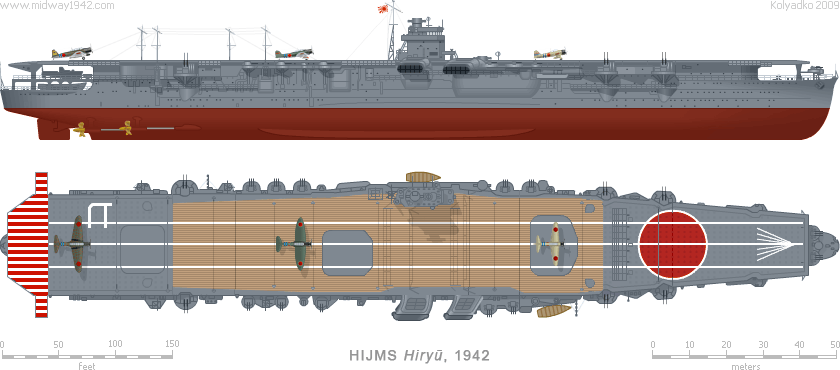
| Hiryū, 飛龍 | AIRCRAFT CARRIER, 航空母艦 | |

| Displacement: | 20,250 t (17,300 t Std) | Machinery: | 8 boilers, 4 shafts | Flight Deck: | 711 ft 6 in 216.8 m | Armor: | 1.8 in (46 mm) belt | |||||||||
|---|---|---|---|---|---|---|---|---|---|---|---|---|---|---|---|---|
| Max Length: | 745 ft 11 in | 227.3 m | Max Power: | 153,000 hp | 114 092 kW | Fighters: | 27× A6M2 Type 0 | DP Guns: | 6× 2× 5 in (127 mm)/40 | |||||||
| Beam: | 73 ft 3 in | 22.3 m | Max Speed: | 34.5 kts | 63.89 km/h | Bombers: | 18× D3A1 Type 99 | AA Guns: | 9× 3× 0.98 in (25 mm) | |||||||
| Draght: | 25 ft 9 in | 7.7 m | Range: | 10,330 nm | 19 131 km | Attack: | 18× B5N2 Type 97 | AA Guns: | 3× 2× 0.98 in (25 mm) | |||||||
* Aircraft as in the largest known Air Group ever carried (during the Pearl Harbor raid).
Hiryū, a slightly enlarged version of Sōryū was laid down on 8 July 1936 at Yokosuka Naval Dockyard, launched on 16 November 1937 and commissioned on 5 July 1939. The ship improved on her smaller sister in a number of respects, notably combat range, engines power, and protection. The most notable difference in appearance was an island superstructure on the port side of the ship. Despite a number of shortcomings, Hiryū was judged to be a highly useful design that was to be reincarnated in the late-war Unryū-class aircraft carriers.
Hiryū was active off China during the next few years. During the opening stages of the Pacific War, she took part in the attack on Pearl Harbor, Wake, Palau Islands, Darwin, Indian Ocean raids, and the battle of Midway, where she was hit by four bombs at 1705, 4 June 1942. The hits caused massive fires on a forward part of the hangar decks. Ten hours after the attack the crew was ordered to abandon Hiryū. The ship was hit by a torpedo from her escort destroyer and sank at 0910, 5 June 1942, at position 31°27' N 178°23' W.